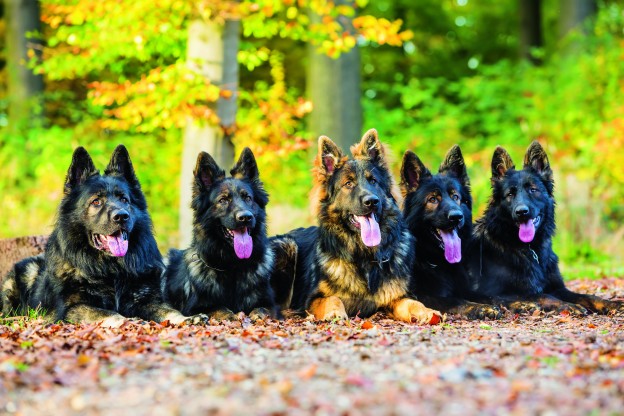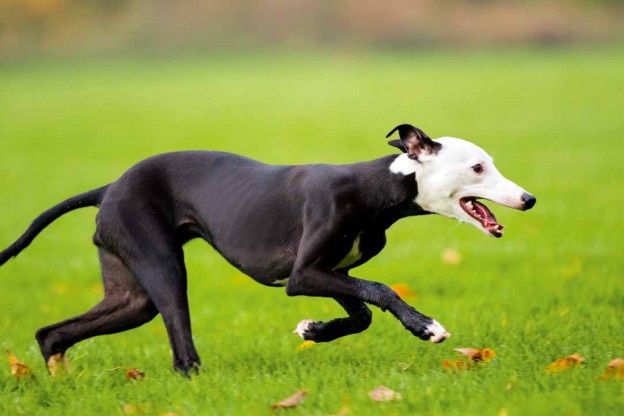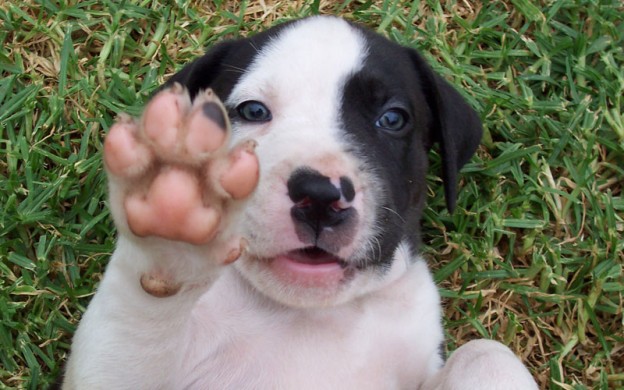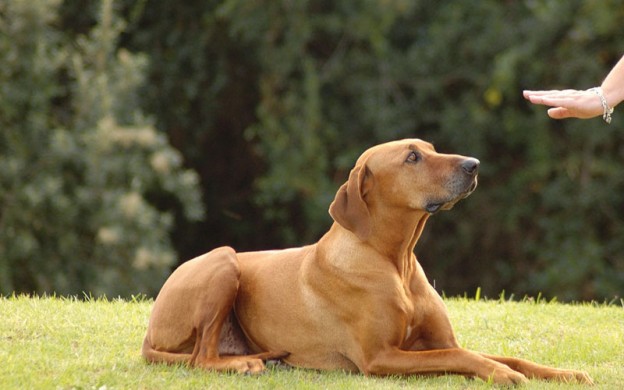Position changes are like the ABCs of dog training. Although you can achieve a reasonable level of control over your dog just by having a reliable sit, teaching stand and down gives you greater options and will make training more interesting. Delta behavioural trainer Karin Larsen Bridge from Get S.M.A.R.T (Successful Motivation And Reward Trained) Dogs shows you how.
Training a reliable sit, stand and down is a more advanced exercise than most people assume. Many dogs will sit when asked in the quiet of their own home, but what about when there are distractions around? Do they sit on a single request or has the cue become sit, Sit, SIT!? Does your dog remain in position until you allow him to get up with a release word? Will your dog sit or drop if you are not facing him or at a distance of more than a few feet? All of these criteria build reliability into positions and all of them take time to train.
A fully trained sit, stand or down happens:
- on ONE presentation of the cue (either a hand signal and/or word)
- from the cue continually until the dog is told to release from position
- regardless of distractions
- regardless of your position
- regardless of whether or not you or the dog are moving.
Another way to think of sits, stands and downs is as a muscle. Today, your dog probably has a weak sit muscle. He has some idea what sit means, but he does not meet all the criteria listed above. Please realise it is not that your dog is disobedient or stupid, you simply haven’t taken the time yet to teach all the components that make a position rock solid and dependable. Only with lots of repetitions will sit, stand or down develop into a really strong, efficient working muscle.
Which position when?
SIT should be your dogs default behaviour or, in other words, if in doubt, sit. Most dogs seem to have learnt that if their owner stares at them and keeps chanting something, a sit usually seems to make them quiet and happy. This is mutually beneficial to dog and human as there are few situations where a sit is a problem. Indeed, it is generally more preferable to the alternatives, such as jumping, running, tugging or chasing. If your dog only reliably learns one command sit is IT.
STAND is useful for easier grooming, vet checks and, of course, is essential for the show ring. It may also be used as an alternative to sit for some large or angular breeds, such as Great Danes and Greyhounds, for whom a sit at every street corner is a rather laborious and tedious task compared to the nanosecond sit of a Jack Russell.
DOWN is the position of choice for longer stays, such as when you are working on the computer, buying a newspaper or at a cafe.
Teaching Sit, Stand and Down
Positions are easily taught using a food lure. The lure should act as a magnet, guiding your dog into position.
To teach sit: Slowly move a small treat above your dogs head. As the head goes up, the bottom will come down and sit happens.
To teach stand: Draw the treat straight forward from the dogs nose until the dog lifts out of the sit into the stand position. This will become the hand signal for stand.
To teach down: Take the treat from the dogs nose, down toward the floor between the dogs toes. This will become the hand signal for down. Leave the treat on the floor to reward.
Remove the treat from your hand after about three repetitions and repeat using the exact same hand movement. This will soon become your visual cue or signal for your dog to sit, stand or down. When your dog is responding to the signal nine times out of 10, it is time to add the word just before the hand signal. Because the dog is very likely to be successful (you have already demonstrated he understands the hand signal), a strong association is quickly made between the word cue and the behaviour, avoiding the common mistake of repetitive cues such as sit, Sit, SIT. Continue to reward AFTER each correct response but begin to vary the reward sometimes food, sometimes a game, sometimes praise alone.
Context cues
There are times when you may not want to have to tell your dog to sit, stand or down; rather you want him to understand that in this situation he is expected to assume this position. For example, you may wait till your dog sits before feeding him his supper, attaching a lead or walking out the door. You may expect your dog to lie down whenever you watch television.
If you are consistent, dogs learn these routine context cues very quickly and they are extremely useful for general good manners training. However, for situations which are not routine, you need to be able to cue sit, stand or down as required.
Adding challenges
Lots of challenges may be added to sit, stand and down. Play around with them to see which may be most useful to you. All challenges will help to improve your dogs understanding of your cues and the behaviour you want.
Hand signal only will your dog change positions on hand signal only? Useful in noisy situations or whenever you would prefer to work quietly with your dog. This is usually the easiest of the challenges for the dog.
Voice cue only will your dog change positions on your word only? To test this, try asking your dog to sit, stand or down with you standing immediately behind the dog, or with your back to the dog (get a friend to watch). How about from another room will your dog still change position when you are out of sight?
The handlers position lure training usually starts with the handler standing directly in front of the dog. This is a useful position when you ask your dog to do things around the home or off-lead in the park. Much of the time, however, your dog will be on lead, by your side. It is important to train your dog to sit, stand and down well by your (usually left) side. Will he respond equally well on the right and left side? What if you are sitting in a chair or lying in bed any difference? There are times at home when you wont want to get up just to ask your dog to sit or down, so practice giving your cues in all sorts of different positions.
Adding distractions will your dog sit, stand or down anytime anyplace, regardless of what is going on around him? If so, take a bow; that’s a hard thing to achieve! Distraction training is great socialisation for your dog. Trainers call it taking it on the road or proofing. When your dog has demonstrated he understands your cues for sit, stand and down at home, start to ask for them in lots of different places. Distractions can include different environments, different surfaces (wet grass or slippery floors), strange sounds (traffic), noisy activities (soccer game) or other dogs. It may be that your dog is not merely distracted by these things, but that they are actually frightened or intimidated by them. Be patient and take the time to make your dog comfortable and confident in the environment before asking for more.
Adding movement if your dog is running toward you, will he sit or drop when cued? How many extra steps does he take before responding? If your dog is running away from you, will he still respond? Adding movement usually means adding excitement, and reliability is likely to decrease. If you have a dog that loves to chase things or simply loves to run, being able to ask your dog to drop mid-flight greatly increases your off-lead control and the safety of your dog and others.
Adding distance how much distance can you add before losing control? One metre, five metres or 20? Distance work provides extra control and safety whenever your dog is off lead. Imagine your dog running toward a road a distant down command stops him in his tracks. Distance work is also essential for TV work, where trainers have to be able to cue their dogs from behind the cameras.
Adding duration there is not a lot of use in teaching a dog to sit, stand or down if he immediately pops up. He must learn to remain in that position until released. Duration is important for general stability and good manners when greeting people at home or in the park, or for settling quietly while you enjoy a coffee or picnic lunch or even while waiting at the vet. How long will your dog hold a position? A few seconds, a few minutes, an hour? Note: Your dog should never be asked to sit or stand for more than a few minutes at a time, howe’ver provided the dog is left in a safe, sheltered area, the down position may be held for much longer periods.
Speed how quickly does your dog respond to your cue? Professional trainers talk about limited hold; if the animal has not performed the behaviour within a predetermined time period, there will be no reward. The dog has missed his chance.
Accuracy does your dog sit, stand and down straight or does he lie crooked or sit back on his haunches? If asked to down, does he creep forward a few steps first? For pet owners, accuracy may be of little importance but in obedience competitions; it is the difference between a poor score and a great one.
A common lament: But he knows sit, perhaps but more likely the sit muscle needs a little more exercise. By working through the challenges above, you too can have a dog that sits, stands or downs everywhere, every time and that is impressive!







